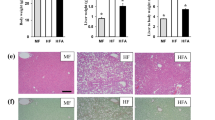Abstract
Acupuncture or electroacupuncture (EA) is effective in treating various metabolism disorders. Previously we found that EA at the acupoint, Fenglong (ST40), had the cholesterol-lowering effect and regulated genes expression in liver of hypercholesterolemia mice (M Li and YZ Zhang, Int J Mol Med 2007, 19: 617–629). To explain gene expression associated with EA, suppression subtractive hybridization (SSH), combined with targeted display (TD), was used and 26 up-regulated and 24 down-regulated genes with known functions were identified in hypercholesterolemia mice liver, some of which are involved in key reactions of lipid metabolism and immune reaction. Promoting lipid metabolism and suppressing inflammation via modulating mRNA expression may be the mechanism of EA inducing modulation of cholesterol concentrations.



Similar content being viewed by others
References
Ahima RS (2005) Central actions of adipocytes hormones. Trends Endocrin Met 16:307–313
Akimoto T, Nakahori C, Aizawa K et al (2003) Acupuncture and responses of immunologic and endocrine markers during competition. Med Sci Sport Exer 35:1296–1302
Aoki E, Kasahara T, Hagiwara H et al (2005) Electroacupuncture and moxibustion influence the lipopolysaccharide-induced TNF-alpha production by macrophages. In Vivo 19:495–500
Bauche IB, Ait El Mkadem S, Rezsohazy R et al (2006) Adiponectin downregulates its own production and the expression of its AdipoR2 receptor in transgenic mice. Biochem Biophys Res Commun 345:1414–1424
Brown AJH, Hutchings C, Burke JF et al (1999) Application of a rapid method (targeted display) for the identification of differentially expressed mRNAs following NGF-induced neuronal differentiation in PC12 cells. Mol Cell Neurosci 13:119–130
Cabioglu MT, Ergene N (2005) Electroacupuncture therapy for weight loss reduces serum total cholesterol, triglycerides, and LDL cholesterol levels in obese women. Am J Chin Med 33:525–533
Cohen P, Miyazaki M, Socci ND et al (2002) Role for stearoyl-CoA desaturase-1 in leptin mediated weight loss. Science 297:240–243
Dabrowski R, Wawron W, Kostrob K (2007) Changes in CRP, SAA and haptoglobin produced in response to ovariohysterectomy in healthy bitches and those with pyometra. Theriogenology 67:321–327
Daveau M, Davrinche C, Julen N et al (1988) The synthesis of human e-2-HS glycoprotein is down-regulated by cytokines in hepatoma HepG2 cells. FEBS Lett 241:191–194
Daveau M, Rouet P, Scotte M et al (1993) Human inter-a-inhibitor family in inflammation: simultaneous synthesis of positive and negative acute-phase proteins. Biochem J 292:485–492
Diatchenko L, Lau YFC, Campbell AP et al. (1996) Suppression subtractive hybridization:a method for generating differentially regulating or tissue-specific cDNA probes and libraries. Proc Natl Acad Sci USA 93:6025–6030
Gadzhiev AA, Mugarab-Samedi VV, Isaev II et al (1993) Acupuncture therapy of constitution-exogenous obesity in children. Probl Endokrinol (Mosk) 39:21–24
Howard OM, Dong HF, Yang D et al (2002) Histidyl-tRNA synthetase and asparaginyl- tRNA synthetase, autoantigens in myositis, activate chemokine receptors on T lymphocytes and immature dendritic cells. J Exp Med 196:781–791
James MN, Makoto M (2004) Regulation of stearoyl-CoA desaturases and role in metabolism. Prog Lipid Res 43:91–104
Johnson BD, Kip KE, Marroquin OC et al (2004) Serum amyloid A as a predictor of coronary artery disease and cardiovascular outcome in women: the National Heart, Lung, and Blood Institute-Sponsored Women’s Ischemia Syndrome Evaluation (WISE). Circulation 109:726–732
Kim JJ, Miura R (2004) Acyl-CoA dehydrogenases and acyl-CoA oxidases: Structural basis for mechanistic similarities and differences. Eur J Biochem 271:483–493
Kim SK, Lee G, Shin M et al (2006) The association of serum leptin with the reduction of food intake and body weight during electroacupuncture in rats. Pharmacol Biochem Behav 83:145–149
Lacey JM, Tershakovec AM, Foster GD (2003) Acupuncture for the treatment of obesity: a review of the evidence. Int J Obes Relat Metab Disord 27:419–427
Lee YN, Nechushtan H, Figov N et al (2004) The function of lysyl-tRNA synthetase and Ap4A as signaling regulators of MITF activity in FcepsilonRI-activated mast cells. Immunity 20:145–151
Li CJ, Cheng XS, Li CY et al. (2005) Regulative effects of acupuncture at Fenglong acupoints on the blood lipids of normal rats and those with hyperlipemia. Chin J Clin Rehabil 27:86–87
Li M, Zhang YZ (2007) Modulation of gene expression in the cholesterol lowering effects by electroacupuncture at Fenglong acupoint (ST40): a cDNA microarray study. Int J Mol Med 19:617–629
Peelmana F, Waelputb W, Iserentanta H et al (2004) Leptin: linking adipocyte metabolism with cardiovascular and autoimmune diseases. Prog Lipid Res 43:283–301
Rebrikov DV, Britanova OV, Gurskaya NG et al (2000) Mirror orientation selection (MOS): a method for eliminating false positive clones from libraries generated by suppression subtractive hybridization. Nucleic Acids Res 28:e90
Sang GP, Hye JK, You HM et al (2005) Human lysyl-tRNA synthetase is secreted to trigger proinflammatory response. Proc Natl Acad Sci USA 102:6356–6361
Van der Westhuyzen DR, Cai L, de Beer MC et al (2005) Serum amyloid A promotes cholesterol efflux mediated by scavenger receptor B-I. J Biol Chem 280:35890–35895
Wu CC, Hsu CJ (1979) Neurogenic regulation of lipid metabolism in the rabbit-A mechanism for the cholesterol-lowering effect of acupuncture. Atherosclerosis 33:153–164
Author information
Authors and Affiliations
Corresponding author
Rights and permissions
About this article
Cite this article
Kang, Y., Li, M., Yan, W. et al. Electroacupuncture alters the expression of genes associated with lipid metabolism and immune reaction in liver of hypercholesterolemia mice. Biotechnol Lett 29, 1817–1824 (2007). https://doi.org/10.1007/s10529-007-9482-7
Received:
Revised:
Accepted:
Published:
Issue Date:
DOI: https://doi.org/10.1007/s10529-007-9482-7




